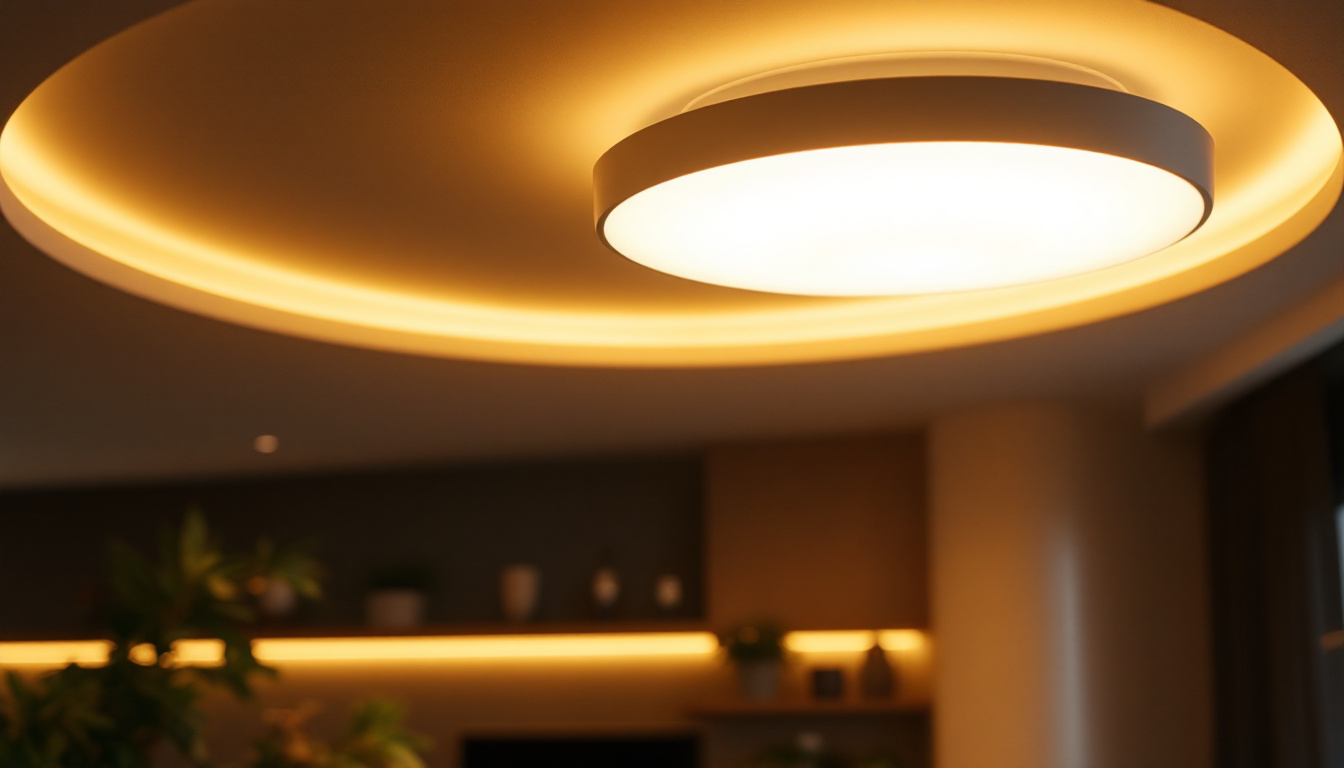
In the realm of modern lighting solutions, ceiling light fixtures have emerged as a pivotal element in achieving energy efficiency. As the demand for sustainable practices grows, understanding the nuances of ceiling light fixtures becomes essential for lighting contractors. This article delves into the various aspects of ceiling light fixtures, exploring their types, benefits, and the role they play in energy-efficient lighting systems.
Ceiling light fixtures serve as the primary source of illumination in residential and commercial spaces. They are designed to be mounted directly to the ceiling, providing widespread light distribution. The choice of ceiling fixtures can significantly influence both the aesthetic appeal and energy consumption of a space.
There is a diverse array of ceiling light fixtures available, each with unique characteristics and applications. Understanding these types helps contractors recommend the best options for specific environments.
Selecting the appropriate ceiling light fixture involves considering several factors, including the purpose of the space, ceiling height, and existing decor. For instance, flush mount fixtures are ideal for areas with low ceilings, while pendant lights can enhance the visual interest in rooms with higher ceilings.
Moreover, the style and design of the fixture should complement the overall aesthetic of the space. An industrial-style pendant may not suit a traditional dining room, just as a classic chandelier may seem out of place in a modern kitchen. Therefore, understanding the context is crucial for making informed recommendations.
In addition to style and height, energy efficiency is another essential consideration when choosing ceiling light fixtures. With the rise of LED technology, many fixtures now offer energy-saving options that not only reduce electricity bills but also have a longer lifespan compared to traditional incandescent bulbs. This shift towards energy-efficient lighting solutions is not only beneficial for the environment but also aligns with modern design trends that prioritize sustainability.
Furthermore, the color temperature of the bulbs used in these fixtures can dramatically affect the mood of a space. Warmer tones can create a cozy and inviting atmosphere, perfect for living rooms and bedrooms, while cooler tones are often preferred in workspaces for their ability to enhance focus and productivity. Understanding the psychological impact of lighting can guide homeowners and designers in selecting fixtures that not only illuminate but also enhance the overall ambiance of a room.
Energy efficiency is no longer just a trend; it has become a necessity in today’s world. This shift is driven by both environmental concerns and the desire to reduce energy costs. Ceiling light fixtures play a significant role in achieving energy-efficient lighting solutions.
Several technologies contribute to energy-efficient lighting, including LED, CFL, and halogen bulbs. Each of these options has distinct advantages that can enhance the energy efficiency of ceiling fixtures.
Incorporating energy-efficient ceiling fixtures offers numerous benefits beyond just lower energy bills. These fixtures can enhance the overall quality of light in a space, contributing to improved mood and productivity.
Furthermore, energy-efficient fixtures often require less maintenance due to their longer lifespans. This translates to fewer replacements and lower costs over time, making them a wise investment for both residential and commercial applications. Additionally, many energy-efficient lighting options are designed with adjustable features, allowing users to customize brightness levels and color temperatures to suit various activities and times of day. This flexibility can create a more inviting atmosphere, whether in a cozy living room or a bustling office environment.
Moreover, the adoption of energy-efficient ceiling fixtures can contribute to sustainability efforts on a larger scale. By reducing energy consumption, these fixtures help decrease the demand on power plants, which in turn lowers greenhouse gas emissions. Many municipalities and organizations are now offering incentives for upgrading to energy-efficient lighting, making it an even more attractive option for those looking to make environmentally conscious choices. As technology continues to evolve, we can expect even more innovative solutions that will further enhance the efficiency and effectiveness of ceiling lighting in our homes and workplaces.
When selecting ceiling light fixtures, design considerations are paramount. The right fixture can enhance the ambiance of a space while ensuring functionality. Here are key aspects to consider:
The style of the ceiling fixture should align with the overall design theme of the room. For contemporary spaces, sleek and minimalist designs are often preferred, while traditional settings may benefit from ornate chandeliers or classic flush mounts. It’s essential to strike a balance between functionality and aesthetics to create a cohesive look.
Effective light distribution is crucial for creating a well-lit environment. Ceiling fixtures should be positioned to minimize shadows and ensure even illumination throughout the space. For larger areas, multiple fixtures may be necessary to achieve the desired lighting effect. Understanding the layout of the room and the activities that will take place within it can guide the selection process.
Integrating dimmer switches with ceiling light fixtures allows for greater control over the lighting levels in a space. This feature not only enhances the ambiance but also contributes to energy savings, as lower light levels consume less energy. When recommending fixtures, it’s important to ensure compatibility with dimmer systems to maximize flexibility and efficiency.
Proper installation of ceiling light fixtures is vital for ensuring safety and optimal performance. Lighting contractors should adhere to best practices to guarantee that fixtures function as intended and meet local building codes.
Before installation, it is crucial to assess the electrical system of the building. Ensure that the circuit can handle the load of the new fixtures, and check for any existing wiring issues that may need to be addressed. Proper grounding and secure connections are essential to prevent electrical hazards.
The height at which ceiling fixtures are installed can significantly impact their effectiveness. For flush mount fixtures, they should be installed close to the ceiling for optimal performance. Pendant lights, on the other hand, should hang at a height that allows for clear sightlines while providing adequate illumination. As a general rule, pendant lights should be hung 30 to 36 inches above a dining table or countertop.
Regular maintenance of ceiling light fixtures is essential to ensure their longevity and performance. Proper care can prevent issues such as flickering lights or reduced brightness, which can detract from the overall aesthetic of a space.
Dust and grime can accumulate on light fixtures, diminishing their brightness and affecting their appearance. Regular cleaning with a soft cloth and mild detergent can help maintain their shine. For intricate designs, a gentle brush may be necessary to reach crevices and ensure thorough cleaning.
Replacing bulbs in ceiling fixtures should be done promptly to maintain consistent lighting levels. When replacing bulbs, it’s essential to use the correct wattage and type to avoid damaging the fixture or creating safety hazards. Keeping a stock of compatible bulbs on hand can streamline this process.
The landscape of ceiling lighting is continually evolving, driven by advancements in technology and changing consumer preferences. Staying informed about future trends can help lighting contractors remain competitive and offer innovative solutions to clients.
Smart lighting technology is gaining traction, allowing users to control their lighting through mobile apps or voice commands. This technology enhances convenience and energy efficiency, as users can easily adjust lighting levels or set schedules. Incorporating smart ceiling fixtures into projects can appeal to tech-savvy clients looking for modern solutions.
As sustainability becomes a priority for many consumers, integrating eco-friendly practices into lighting design is essential. This includes using materials that are recyclable or sourced sustainably, as well as promoting energy-efficient technologies. Contractors who prioritize sustainability can differentiate themselves in a competitive market.
Ceiling light fixtures are more than just sources of illumination; they are integral to creating energy-efficient, aesthetically pleasing spaces. Understanding the various types, benefits, and installation practices associated with these fixtures is crucial for lighting contractors aiming to provide exceptional service.
By prioritizing energy efficiency and staying abreast of emerging trends, contractors can offer valuable insights and solutions to clients. As the demand for sustainable lighting solutions continues to grow, embracing these practices will not only enhance the quality of lighting projects but also contribute to a more sustainable future.
Ready to elevate your lighting projects with energy-efficient solutions that blend quality, affordability, and convenience? Look no further than LumenWholesale, where we provide contractors with spec-grade lighting products at unbeatable wholesale prices. Say goodbye to inflated markups and hello to a vast selection of premium lighting that meets the highest industry standards. Plus, enjoy the ease of bulk buying with free shipping, ensuring you get the best value without any hidden fees. Don’t compromise on your lighting needs—visit LumenWholesale for Wholesale Lighting at the Best Value and make your next project shine.

Discover how high hats light technology can revolutionize your projects by saving lighting contractors both time and money.

Explore the transformative impact of recessed wall lights in contemporary interior design.

Discover the top resources for LED long light bulbs that lighting contractors trust.

Discover the essential guide for lighting contractors on integrating solar panels with lighting systems.